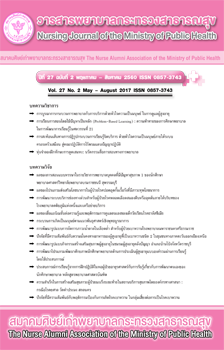ผลของสื่อแอนิเมชั่นต่อความรู้และพฤติกรรมการดูแลตนเอง ของเด็กวัยเรียนโรคธาลัสซีเมีย
Main Article Content
Abstract
บทคัดย่อ
การศึกษาครั้งนี้เป็นการวิจัยกึ่งทดลอง เพื่อศึกษาผลของสื่อแอนิเมชั่นต่อความรู้และพฤติกรรม การดูแลตนเองของเด็กวัยเรียนโรคธาลัสซีเมีย โดยเปรียบเทียบความรู้และพฤติกรรมการดูแลตนเอง ระหว่างกลุ่มทดลองและกลุ่มควบคุม ในระยะก่อนและหลังการทดลอง
กลุ่มตัวอย่างเป็นเด็กวัยเรียนโรคธาลัสซีเมีย ใช้วิธีเลือกกลุ่มตัวอย่างแบบเจาะจงโดยจับคู่ตามคุณสมบัติและสุ่มจับฉลากเข้ากลุ่มทดลองและกลุ่มควบคุม กลุ่มละ 25 คน เครื่องมือที่ใช้ในการวิจัยประกอบด้วยแบบสอบถามข้อมูลส่วนบุคคล แบบสัมภาษณ์ความรู้และพฤติกรรมการดูแลตนเองและสื่อแอนิเมชั่น หาคุณภาพของเครื่องมือโดยการตรวจสอบความตรงตามเนื้อหาจากผู้ทรงคุณวุฒิ จำนวน 3 ท่าน แบบสัมภาษณ์ความรู้เรื่องโรคธาลัสซีเมีย วิเคราะห์ความเชื่อมั่นโดยใช้สูตรคูเดอร์ ริชาร์ดสัน ได้ค่าความเชื่อมั่น เท่ากับ .74 และแบบสัมภาษณ์พฤติกรรมการดูแลตนเอง วิเคราะห์ความเชื่อมั่นโดยใช้สูตรสัมประสิทธิ์ แอลฟาครอนบราค ได้ค่าความเชื่อมั่นเท่ากับ .95 วิเคราะห์ข้อมูลด้วยการแจกแจงความถี่ ร้อยละค่าเฉลี่ย ส่วนเบี่ยงเบนมาตรฐาน การทดสอบไคสแควร์ และการวัดความแปรปรวนทางเดียวแบบวัดซ้ำ
ผลการวิจัย พบว่า กลุ่มทดลองมีคะแนนเฉลี่ยของความรู้และพฤติกรรมการดูแลตนเองสูงขึ้นระยะหลังการทดลอง 2 สัปดาห์ และ 4 สัปดาห์ อย่างมีนัยสำคัญทางสถิติ (p<.01) และคะแนนเฉลี่ยความรู้และพฤติกรรมการดูแลตนเองสูงกว่ากลุ่มควบคุมอย่างมีนัยสำคัญทางสถิติ (p<.01) เมื่อวิเคราะห์ความแปรปรวนแบบวัดซ้ำ พบว่า คะแนนเฉลี่ยความรู้และพฤติกรรมการดูแลตนเองระหว่างกลุ่มทดลองและกลุ่มควบคุม ภายหลังการทดลอง 2 สัปดาห์และ 4 สัปดาห์ แตกต่างกันอย่างมีนัยสำคัญทางสถิติ (p<.01)
จากผลการวิจัยแสดงให้เห็นว่าสื่อแอนิเมชั่นเป็นการ์ตูนที่สามารถถ่ายทอดเรื่องราวเกี่ยวกับโรคธาลัสซีเมีย และการปฏิบัติการดูแลตนเองที่ถูกต้อง เข้าใจง่ายและจดจำเนื้อหาได้ดีจนเกิดการรับรู้และมีแรงจูงใจที่ส่งผลให้เกิดพฤติกรรมการดูแลตนเองที่ถูกต้องตามมาได้
The Effect of Animation Media on Knowledge and Self-Care Behavior
of School-Age Children with Thalassemia
Suchada Prabmeechai *
Somsamorn Rueangworaboon **
Abstract
This quasi-experimental research study was conducted to investigate the effects of animation media on knowledge and self-care behavior of school-aged children with thalassemia. The knowledge and self-care behavior of the children in the experimental group and the control group before and after the experiment were compared.
The sample consisted of school-aged children with thalassemia. A purposive sampling technique was used to recruit the children. The children were matched and randomly put into the experimental group and the control group. Each group consisted of 25 children. The tools used in the study included a questionnaire on demographic data, interview forms about knowledge, self-care behavior, and animation media. The content validities of the tools were examined by 3 experts while the reliabilities of the interview forms about knowledge and self-care behavior were determined by Kuder Richardson KR-20 and Cronbach’s alpha coefficient with the results of .74 and .95, respectively. The data were analyzed by frequency, percentage, mean, standard deviation, chi-square, paired t-test and one-way repeated measures ANOVA.
The study revealed that the mean scores of knowledge and self-care behavior of the experimental group were significantly higher after two weeks and four weeks of the experiment at p<.01. After the experiment, the experimental group displayed a significantly higher average knowledge and self-care behavior scores than the control group. According to the analysis using one-way repeated measures ANOVA, it was found that the mean scores of knowledge and self-care behavior of the experimental group after two weeks and four weeks of the experiment were significantly higher than those of the control group at p<.01.
The findings indicated that animation media can correctly and simply tell the story about thalassemia and self-care behavior so that children can understand and remember it. This can increase their awareness and motivation to improve their self-care behavior.
* Nakhon Phanom, Nakhon Phanom University
Article Details
บทความและรายงานวิจัยในวารสารพยาบาลกระทรวงสาธารณสุข เป็นความคิดเห็นของ ผู้เขียน มิใช่ของคณะผู้จัดทำ และมิใช่ความรับผิดชอบของสมาคมศิษย์เก่าพยาบาลกระทรวงสาธารณสุข ซึ่งสามารถนำไปอ้างอิงได้
